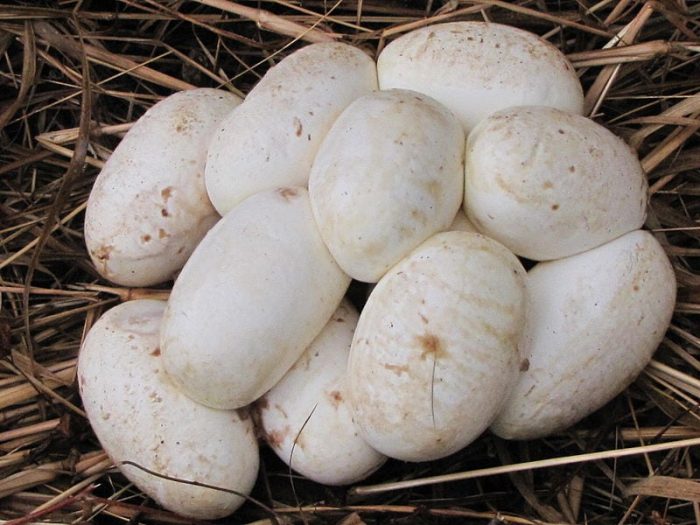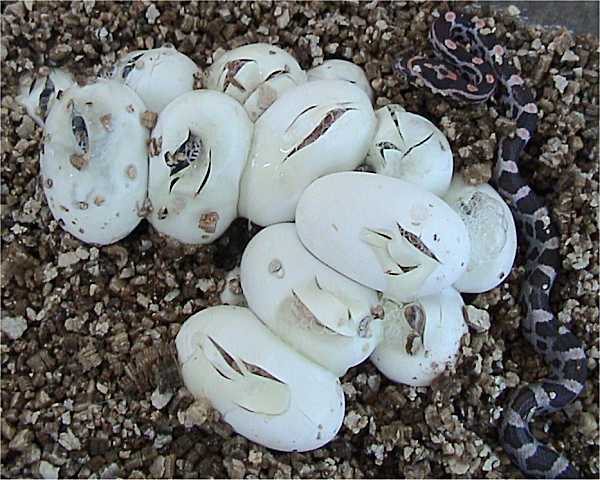
The eggs of snakes can be identified by a number of different characteristics including the appearance, hardness, and shape of the eggs. Snakes usually lay their eggs in sand or soil which helps incubate the eggs, and then most species of snakes will leave and not watch over the nest after laying the eggs. Let’s take a closer look at the eggs of snakes and how they can be identified.
Before jumping into how the eggs of snakes can be identified, it would be helpful to know a little about snakes themselves.
Facts About Snakes

A python wrapped around a clutch of eggs. Photo: Tigerpython via Wikimedia Commons, CC-BY 3.0 https://creativecommons.org/licenses/by/3.0/deed.en
Snakes are reptiles that belong to the suborder Serpentes. They have no limbs and have elongated bodies. Though many people think of snakes as venomous creatures, in reality, most snakes don’t have venom. Of the approximately 2900 species of snakes on the planet, only around 375 of them are venomous.
“Every great story seems to begin with a snake.” — Nicholas Cage
Snakes can be found on just about every continent, with the exception of Antarctica. Snakes also aren’t present in Iceland, Ireland, New Zealand, and Greenland. The vast majority of snakes live in tropical regions, but snakes can make many different habitats their homes, including deserts, prairies, forests, and even bodies of water.
There are approximately 20 different families of snakes, most of which can be categorized in one of the five major snake families found below:
- Colubridae snakes make up the majority of snakes on the planet, around 1900 different species. They are referred to as colubrids, and they are mainly non-venomous.
- Boidae is the family that includes boa snakes and they make up 40 – 45 different individual snakes. Boa snakes are all non-venomous constrictors.
- Elapidae snakes include a variety of different venomous species slike taipan snakes, mambas and cobras. Snakes in the elapidae family are all venomous.
- Pythonidae is colloquially referred to as “pythons” and they include some of the longest snakes in the world.
- Viperidae, frequently just called vipers, including rattlesnakes, vipers, and other venomous snakes.
Snakes are capable of consuming a wide variety of different insects and animals to sustain themselves. The prey that a snake subsists on depends upon the type of snake and its size. Some smaller snakes feed on things like termites, while many snakes eat birds, rodents, frogs and toads. Larger snakes can eat whole deer and pigs. Some snakes even eat other snakes. Snakes have different methods of hunting. Constrictor snakes squeeze their prey to kill it and then swallow it while venomous snakes paralyze or kill their prey with their venom. Snakes typically don’t need to hunt every day. Some pythons and anacondas are capable of surviving up to a year without food after they feed.
Snakes sense the world around them by using their tongue. The tongue of snakes is extremely sensitive and can sense vibrations in the air, allowing them to navigate and hunt their prey. Some species, like pythons, pit vipers, and boas have infrared receptors located in grooves along their face, which helps them sense the heat of warm-blooded animals (prey). Snakes are ectothermic creatures (cold-blooded creatures) so they have to regulate their body temperature externally. They do this by lying in warm patches of sunlight or cooling themselves off in shaded areas. Snakes shed their skin somewhere between three to six times every year, depending on the species. Snakes are primarily nocturnal, though there are a few species of snakes that are diurnal or crepuscular. Snakes have several different methods of locomotion, such as undulating left and right to move around, or sidewinding.
Snake Reproduction
Snakes reproduce through the process of internal fertilization. The male’s tail has a forked pair of hemipenes, or reproductive organ similar to a penis in mammals. The male snakes grip the walls of the female’s cloaca with this organ.

Python molurus eggs. Note the leathery appearance and the shape. Photo: Jayendra Chiplunkar via Wikimedia Commons, CC-BY-SA 3.0 https://creativecommons.org/licenses/by-sa/3.0/deed.en
Most species of snake lay eggs rather than giving birth to live young, though there are a few species of snakes that give birth to live young. Snakes will lay their eggs in a relatively warm location to incubate them, such as in the sand or soil or in patches of grass. Most snakes do not stick around to rear their young or make sure the eggs hatch after laying the eggs, though some species of python do. A few species of snakes, like the King Cobra, construct nests and stay in the area to make sure the eggs hatch. Pythons are known for coiling around their nests and incubating the eggs/protecting them until they hatch. Some snakes retain the eggs within their own bodies until the eggs are just about ready to hatch.
Identifying Snake Eggs
If you’ve found eggs near your home and want to determine if they are snake eggs, you can try the following:
- Gently feel the eggs. Reptile eggs are typically rather soft in comparison to bird eggs, which are notably harder. The eggs of snakes are usually leathery feeling. If you are examining the egg under a bright light source, like the light of an artificial incubator, you may be able to just barely make out the outline of the embryo inside the egg.
- Trying shining a bright flashlight at the egg, and if the embryo inside is a round shape, it is probably a snake egg. Snakes eggs are typically oblong, though some species of Asian and African snakes lay eggs that look like thick grains of rice or ginger roots. Snakes found throughout South America and North America typically have eggs that are shaped similar to bird eggs.
- You can also have the eggs checked at a local wildlife or pest control center, who should be able to confirm for you whether or not the eggs you are looking at are snake eggs and which type of snake the eggs belong to.
- The size of the clutch may also help you determine what kind of eggs you’re looking at. Snakes can lay anywhere between one to one hundred eggs at a time. If you have stumbled across a nest containing dozens of eggs, they are probably not from a bird.

Corn snake eggs. Photo: Dawson via Wikimedia Commons, CC-BY-SA 2.5 https://creativecommons.org/licenses/by-sa/2.5/deed.en
Try not to disturb any eggs you find in the wild. They will die if they are outside of a few inches of dirt, or peat moss, etc. for too long. The eggs need to be around 80 degrees Fahrenheit, so they can’t survive being cold for too long. Rough handling of snake eggs can kill the embryo inside because of the soft nature of the shell. The eggs of snakes usually hatch in around 60 days, though this naturally changes depending upon the species of the snake.
If you’re concerned about eggs you found near your home being snake eggs, it is advised that you get an expert opinion from a wildlife expert. Snakes rarely attack humans unprovoked, but they can do great (potentially fatal) damage to humans if they bite. They’ll be able to help you determine what kind of eggs are in your backyard and help you keep your family, as well as the eggs, safe.









